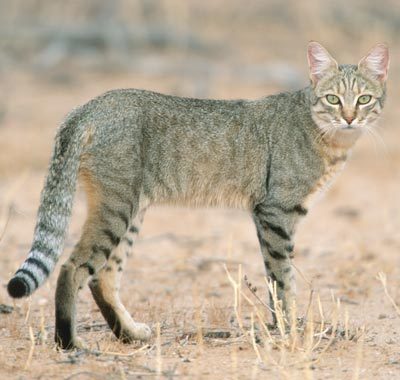Aww! Wook at the wittle puddy-tat… Argh! Wait, that isn’t a puddy cat at all, it is actually Felis silvestris lybica, the African wildcat, a formidable crepuscular predator which ranges across the Sahara and Sahal up through the Arabian Peninsula and around the Caspian Sea. Although they are remarkable hunters, African wildcats are not large—males measure 46–57 cm (18–22 in) in head-to-body length (discounting the elegant tail) and weigh from 3.2 to 4.5 kg (7 to 10 lbs). Using stealth, speed, retractable claws, and athletic lunges, the wildcats hunt and kill everything smaller than themselves: small mammals are their main prey but cats also kill birds, reptiles, insects, amphibians, and miscellaneous arthropods. African wildcats hunt mostly at dawn and dusk, but thanks to incredibly keen senses, they can also hunt at day or night.
The senses of the African wildcat are truly astonishing. Their large vertically slitted eyes are extremely efficient in brightest day or in the faintest light (thanks partly to the tapetum lucidum—a layer of reflective cells at the back of the eye which reflects light back into the photoreceptors). Wildcat hearing is among the best in the animal kingdom—they can hear many ultrasonic noises inaudible to humans and dogs (cats developed this sense because many rodents and insects communicate with such noises). Their large mobile ears further augment their acute hearing. Although they do not have the unbelievable noses of dogs or wolves, wildcats have an amazing sense of smell which is estimated to be 14 times more acute than a human’s. Additionally, their heads (and particularly their faces) are covered with vibrissae (whiskers) to help wildcats sense vibrations and navigate in tight pitch black spaces.
As well as keen senses, African wildcats possess other features which help them fit into their harsh arid environment. They have striped stippled coats which are the color of rocks, dry grass, and earth—so they blend in to most environments effortlessly (although they tend to have lighter colored bellies). Living in vast deserts, African wildcats have shockingly efficient kidneys. The animals can live without water on the fluid from prey animals. If necessary, they can rehydrate with seawater. They can also survive extremely hot temperatures and do not show discomfort until 52 °C (126 °F).
Felis silvestris lybica is actually one of several subspecies of old world wildcat Felis silvestris which ranges across all of Europe, Africa, and Asia. Wildcats are very, very versatile, resilient, and effective predators, yet all of the subspecies of wildcat are gradually losing their genetic diversity except for the African wild cat. This is because of interbreeding with the domestic cat Felis silvestris catus. As you have probably gathered by now, domestic cats descend directly from a handful of African wildcats which were domesticated in the Fertile Crescent between 10,000 and 9,000 years ago when humans first became grain farmers. The first domestic cat was found buried in a Neolithic grave in Cyprus which dates back to 9,500 years ago. The wildcats (Felis silvestris) are all fully fertile when breeding across species, so some of the differences between the wildcat and the domestic cat are fairly arbitrary.






3 comments
Comments feed for this article
June 20, 2018 at 11:58 PM
Feral cat caught on camera. | The Mild Adventurer
[…] compare in shape to my feral cat. https://wildcatconservation.org/wild-cats/africa/african-wildcat/ https://ferrebeekeeper.wordpress.com/2013/09/06/the-african-wildcat/ http://mpalalive.org/field_guide/african_wildcat […]
February 15, 2020 at 6:31 PM
Snowbrush
I too am a cat lover (and rescuer), and am very interested in most things cat. In regard to Felis silvestris lybica, are you familiar with the book, “The Cat in Ancient Egypt”?
If the photos are yours, might I use the top one in my own blog?
July 2, 2020 at 9:36 AM
Dina
Hi there, are these photos yours? if yes would you be able to give me some details about where the first one is taken, and could i possibly use it in my research project (with your credit, of course)? feel free to contact me via email to share details. thanks a lot!